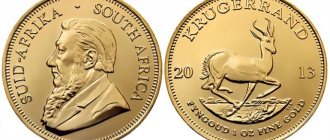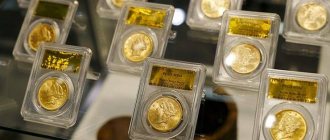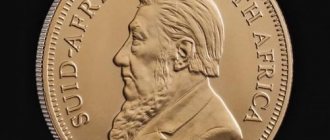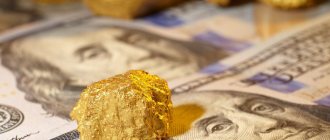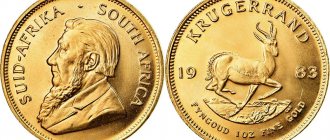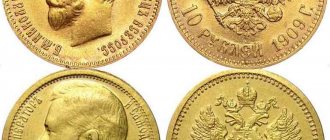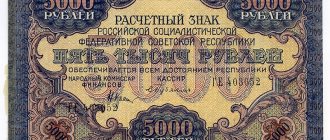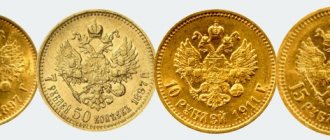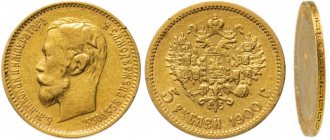Chinese coins of the Golden Panda series are investment samples issued in China since 1982. The first circulations were carried out in limited quantities , so the coins aroused interest not only among investors, but also among collectors. “Pandas” have received recognition along with the Australian coins of the Nugget and Lunar series, the American Buffalo, the Austrian Philharmoniker, the South African Krugerrand and the Canadian Maple Leaf.
Story
The first money appeared in Ancient China about 3,000 years ago. At first, the inhabitants of the Middle Kingdom used cowrie shells for trade, then coins of various shapes (hoe, knife, spatula and ring), as well as fabric, grains and precious stones came into use.
Beginning in the 5th century, coins became more popular. More often they were made of bronze, copper or iron, less often - of gold and silver. At that time, precious metals were very rare, so gold and silver bars were used only for large transactions.
Did you know? Recently, the largest gold coin ever minted in that country (one of 20 copies) was put up for auction in China at the Guardian. In 2000, it was considered the largest in the world. On May 14, 2011, the coin was sold for approximately $1.18 million. Its denomination was 30,000 yuan, weight – 10 kilograms, purity – 99.99% pure gold. The current record holder is the Canadian Maple Leaf. The weight of the coin is 100 kg, diameter – 50 cm, thickness – 3 cm.
Ancient coins made of precious metals are very rare. Until the 20th century, silver was used for coinage, and gold in the form of coins never participated in the monetary circulation of China.
Only after the overthrow of the Qing dynasty (1912) did the production of gold coins in denominations of 5, 10 and 20 dollars with portraits of Chinese leaders begin. These copies never made it into circulation. Their purpose was memorial - distribution in the form of awards.
A small number of coins made of precious metals have survived to this day, since power in China changed quite often. With each new ruler, coins were confiscated from the population and melted down.
The Chinese themselves preferred to use coins made of non-ferrous metals for trade, and later paper money. Also, the inhabitants of the Middle Kingdom melted coins into bars, preferring to store precious metals in this form.
The first gold coins found in Southern China (205 BC - 900 AD) were rectangular in shape, more like ingots. The coins were called "yuan", which translated meant "ingot".
Only hieroglyphs were depicted on their surface - the first Chinese gold coins did not carry a specific meaning and were not distinguished by exquisite designs. Their weight ranged from 8.21 to 17.53 g.
Did you know? Lu Xun (1881-1936) is one of China's greatest writers of the 20th century and the founder of modern Chinese literature. But few people know about his contribution to Chinese numismatics. The writer was an avid collector of ancient Chinese coins and the author of a manuscript annotating the coins of China from the 7th to the 17th centuries. The manuscript was written in 1913, when Lu Xun worked at the Ministry of Education in Beijing. At that time, he began studying ancient books about Chinese coins and often visited Liulichang Street to expand his collection. He cataloged 1,311 coins ranging from the Tang Dynasty to the Song Dynasty.
The production of coins from precious metals in China belonged to the kingdoms:
- Shu (221-265);
- U (222-280);
- Southern Liang (502-556);
- Northern Qi (550-577);
- Northern Zhou (557-581).
After the appearance of the first paper money (960-1127) during the reign of the Northern Song Dynasty, gold and silver coins began to be produced only for special events. The first copies looked more like medals than a means of trade (the obverse depicted a portrait of the ruler).
Until 1189, banknotes were distrusted as a form of currency that was not backed by state guarantees. Paper money was replaced with silver coins, but even this step did not help to cope with inflation (most of the ancient samples were again melted down by the Chinese population).
During the Song Dynasty, the first designs and calligraphic signatures of beauty and sophistication appeared on the surface of gold and silver coins. On the front side you can see images of dragons, horses and fantastic animals.
This feature indicates that coin production is beginning to flourish in China. The pictures are accompanied by information about the year of production and region.
Did you know? The earliest gold coins in Ancient China were found in the south of the country - in the kingdom of Chu. There was a stamped inscription “Ying Cheng” on the surface. Ying (Ying) is the name of the capital of the kingdom of Chu, and Cheng (Cheng) is read as Yuan (a metric unit of weight and the name of money).
After the Mongol tribes conquered the Chinese state, for the next 300 years only bronze was used to produce coins. In 1693, silver ingots called “liang” were produced. The weight of the ingot was approximately 36 g.
It was used to pay tax duties until 1933. In 1835, the first edition of silver yuan coins was released. The cost of one coin was equal to 0.72 liang. At times, coins weighing 1 liang (37 grams) were minted. In 1889, a new Chinese monetary standard appeared:
- 1 yuan – 10 zhao;
- 1 tsao – 10 fen;
- 1 fen – 10 wen.
Unlike European coin production, Chinese craftsmen cast coins rather than mint them. For each specimen, two forms were used - slabs of pressed sand. Metal was poured into one, the other was covered and coated with clay to prevent displacement. The surface indicated the weight, denomination and location of casting.
Since 1979, a program for issuing investment and commemorative coins made of precious metals has been developing in China. The first, smallest edition belongs to the rare and highly desirable “Year of the Child” series. A total of 2,000 coins were issued in gold and 500 in silver. At auctions, these coins were sold for $143,000.
Rare Chinese gold and silver coins from 1979 to the present day:
- 500 Yuan Gold Proof 1993;
- 500 yuan gold Marco Polo series 1993;
- 20 yuan of the 1995 Golden Chinese Panda series;
- 50 Yuan silver coin in honor of "Zhong Kui" 2012.
The first series of Chinese investment coins of the “Panda” series made of gold and silver are rare specimens, since their circulation was only 10-20 thousand pieces. Due to the limited edition, the cost of these coins consists of the cost of the precious metal and the numismatic value.
Golden Panda - Circulation and denomination
The Chinese national currency is the yuan. Until 2005, Chinese gold Panda coins were issued in denominations ranging from 500 (1 oz) to 5 yuan (1/20 oz); one ounce equals a weight of 31.1 grams. After 2005, the denomination was increased by a factor of four, with the result that one ounce currently corresponds to a denomination of 2,000 yuan (i.e. 289 euros). The increased denomination only applies to weights from 5 to 1/10 ounce, the 1 gram coin retains the denomination of 3 yuan. The denomination of coins weighing from 5 ounces to 10 kilograms, which corresponds to 10,000 yuan, has not changed.
Circulation: In the first two years of production - in 1982 and 1983 - circulations were very small. In these years, only 13,500 and 23,500 pieces were issued, respectively, so coins from these years of issue are especially valued by collectors. Until 2010, the quantity was limited to 101,000 copies, but then circulations began to reach 1,000,000 pieces per year.
In addition, there is a feature of dividing Panda gold coins by denomination. If coins from the same "league" (for example, coins in honor of the Vienna Philharmonic, Maple Leaf and Krugerrand) weigh from 1 to 1/25 ounce (corresponding to 1.24 grams), then in this case the situation is different: The smallest gold Panda weighs 1 gram, or 0.032 ounces. The largest gold Panda coin weighs 10 kilograms, which is equivalent to 321.4 ounces. As of 2021, Panda gold coins have been converted to the metric system, with rounded values. Thus, an "ounce" for a Panda coin is only 30 grams.
Design
Drawings on ancient coins make it possible to trace how the minted art of China developed. If the oldest examples do not have signatures, then on later copies there are abstract inscriptions (ancient Chinese characters) and images (dragon, unicorn, phoenix). Modern rare gold and silver coins (commemorative and investment) are minted in Proof quality by hand.
Did you know? One of the most recognizable coins in the world of numismatics is the silver dollar with the profile of Sun Yat-sen (Chinese revolutionary and founder of the Kuomintang Party) on the obverse and the inscription “Memento Birth of the Republic of China” on the reverse. An earlier version of the coin was issued in 1912 to commemorate the founding of the Republic of China. But production ceased when Yuan Xikai became president in 1913.
The design of precious metal coins has improved markedly over time. In the Tang era, the reverse was decorated with an inscription of 4 hieroglyphs “nianhao” - the motto of the ruling dynasty, and the obverse was decorated with 2 hieroglyphs (the abbreviation for “nianhao” and the year of issue). Years later, graphic art (calligraphy) in China received great development. During the Song period, cursive handwriting and the first images appeared on the surface.
After the Xinhai Revolution of 1911 and the subsequent collapse of the empire, portrait coins made of precious metals appeared in China. Rare $1 examples contained portraits of General Yuan Shikai, Emperor Guangxu, and revolutionary Sun Yat-sen. The most expensive coin of that period, the 1927 $50 with a portrait of Zhang Zuo Lin, was sold at auction for $500,000.
In 1982, the first Proof coins appeared in gold, and in 1983, in silver. Popular, but rare (circulation was 20,000 copies) depicting the national animal - the panda in its natural habitat.
Investors and collectors liked the “Panda” series so much that every subsequent year (except 2001-2002) they released an edition with a new design. The coins immediately went into collections. The cost of the first Pandas reaches $4,000.
Circulation
The first batch of Golden Pandas was released in a circulation of 10,000 copies. The popularity of the coin among investors and collectors increased almost immediately, so the issue was increased every year. In 2021, demand reached its peak and it was decided to increase the circulation from 60,000 to 70,000 copies.
Did you know? The panda is synonymous with Chinese culture and history. In China, the animal is believed to have medicinal and spiritual properties. This belief was especially widespread during the reign of the Ming Dynasty. Residents of the Middle Kingdom believed that the presence of a panda in the family would bring healing and comfort in life or during battle.
Price
The cost of rare Chinese gold and silver coins varies depending on circulation and demand. Gold coins in XF quality from 1906 cost $200-300 at auction, and $400-600 in AU quality. Silver examples from the revolutionary period cost from $400 to $1,000. In 2015, a Han-Sin silver dollar was auctioned for $1,300.
The price for modern commemorative coins (1982-1995) made of gold reaches $1500-4000 (“Panda” with a face value of 100 yuan), for silver coins – from $150 to $300.
Panda Coin – Features
Along with the features that consist in changing the obverse motif, there are features associated with the motif on the reverse of the Panda coin. At first glance, the motive does not change, but an experienced specialist will notice subtle differences. The marble terrace has a fence, and the number of fence posts varies from year to year:
- Coins from 1983–1986 show 6 pillars on each side
- Coins from 1987–1991 show 5 pillars on each side
- Coins from 1992–2001 show 4 pillars on each side
- Since 2002, 3 pillars have been depicted on each side.
